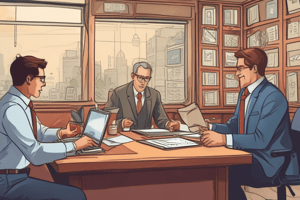Podcast
Questions and Answers
What is the main reason it's important to listen to customer complaints?
What is the main reason it's important to listen to customer complaints?
- To prevent potential churn and improve the customer experience. (correct)
- To show customers that you're always right.
- To avoid dealing with difficult customers.
- To prove that the customer is wrong.
Customer complaints are exclusively submitted privately through surveys.
Customer complaints are exclusively submitted privately through surveys.
False (B)
What metric is commonly used in restaurant drive-thrus to measure wait times?
What metric is commonly used in restaurant drive-thrus to measure wait times?
Average Time on Hold (ATH)
A long-term solution to the problem of customers repeating their issue is to invest in ______ software.
A long-term solution to the problem of customers repeating their issue is to invest in ______ software.
What should staff do when they don't have the answer to resolve a customer's issue immediately?
What should staff do when they don't have the answer to resolve a customer's issue immediately?
Dealing with all customer complaints with the utmost care is not essential to business success.
Dealing with all customer complaints with the utmost care is not essential to business success.
What should you look for opportunities to do rather than criticize staff?
What should you look for opportunities to do rather than criticize staff?
When you do have to follow up on a case, your staff should be dedicated to ______.
When you do have to follow up on a case, your staff should be dedicated to ______.
Match the following types of customer complaints with the appropriate actions to take:
Match the following types of customer complaints with the appropriate actions to take:
What is the first step in the seven-step customer complaint procedure?
What is the first step in the seven-step customer complaint procedure?
Customer complaints are always a result of a mistake made by the business.
Customer complaints are always a result of a mistake made by the business.
What does a proactive customer service entail when a product is out of stock?
What does a proactive customer service entail when a product is out of stock?
Studies show that 67% of customer churn is avoided if the service request is fulfilled during the ______.
Studies show that 67% of customer churn is avoided if the service request is fulfilled during the ______.
What should you do for a truly stellar customer experience?
What should you do for a truly stellar customer experience?
When handling customer complaints, it is always appropriate to disagree or argue with the customer to prove your point.
When handling customer complaints, it is always appropriate to disagree or argue with the customer to prove your point.
Besides apologizing, what is another crucial step in resolving a customer complaint?
Besides apologizing, what is another crucial step in resolving a customer complaint?
The expressive complainer may use ______ to express their dissatisfaction.
The expressive complainer may use ______ to express their dissatisfaction.
Which of the following best describes the key trait of an aggressive complainer?
Which of the following best describes the key trait of an aggressive complainer?
Ignoring a chronic complainer is an effective strategy, as they are never satisfied.
Ignoring a chronic complainer is an effective strategy, as they are never satisfied.
For dealing with an aggressive complainer, what should be avoided?
For dealing with an aggressive complainer, what should be avoided?
The best thing you can do for a dissatisfied customer is to ______ listen.
The best thing you can do for a dissatisfied customer is to ______ listen.
What is one way to help deal with Indecisive Izzy?
What is one way to help deal with Indecisive Izzy?
A Cautious Charlie is hard to satisfy.
A Cautious Charlie is hard to satisfy.
How should you speak with Impulsive Ivan?
How should you speak with Impulsive Ivan?
When dealing with talkative tammy,______ down what she wants.
When dealing with talkative tammy,______ down what she wants.
Which of the following best describes the key trait of an Demand Devin?
Which of the following best describes the key trait of an Demand Devin?
For dealing with an Know-It-All Kevin, you should not take anything personally.
For dealing with an Know-It-All Kevin, you should not take anything personally.
When dealing with aggressive Abigail, what is most important to do?
When dealing with aggressive Abigail, what is most important to do?
One way to help Best Deal Barbara is to ______ expectations.
One way to help Best Deal Barbara is to ______ expectations.
Which of the following best describes the key trait of an No Boundaries Nikki?
Which of the following best describes the key trait of an No Boundaries Nikki?
It is ok to offer excuses when dealing with a Complaining Chad.
It is ok to offer excuses when dealing with a Complaining Chad.
How should you deal with an Unattentive customer?
How should you deal with an Unattentive customer?
A Dysfunctional Door knob will fall under which category?
A Dysfunctional Door knob will fall under which category?
Which of the following best describes the key trait of an Accident?
Which of the following best describes the key trait of an Accident?
Racism is an example of a typical complaint
Racism is an example of a typical complaint
What category does poor linen fall under?
What category does poor linen fall under?
[Blank] is example of service rated
[Blank] is example of service rated
Match the following food related complaints with the appropriate actions to take:
Match the following food related complaints with the appropriate actions to take:
What are customers your
What are customers your
It's ok to not bend the rules when dealing with customer issues.
It's ok to not bend the rules when dealing with customer issues.
What is important to do after you resolve customer issues?
What is important to do after you resolve customer issues?
Flashcards
What are customer complaints?
What are customer complaints?
Negative feedback consumers provide about a company's product, service, or support experience.
What is "Long wait on hold"?
What is "Long wait on hold"?
A customer has to wait too long when calling a business and is put on hold.
What is "Unavailable product"?
What is "Unavailable product"?
Customers are unable to purchase a product because it is out of stock or unavailable.
Repeating the Problem
Repeating the Problem
Signup and view all the flashcards
Uninterested Staff / Personnel
Uninterested Staff / Personnel
Signup and view all the flashcards
Poor Product or Service
Poor Product or Service
Signup and view all the flashcards
No First Call Resolution
No First Call Resolution
Signup and view all the flashcards
Lack of Follow Up
Lack of Follow Up
Signup and view all the flashcards
New Feature Requests
New Feature Requests
Signup and view all the flashcards
Aggressive Complainer
Aggressive Complainer
Signup and view all the flashcards
Expressive Complainer
Expressive Complainer
Signup and view all the flashcards
Passive Complainer
Passive Complainer
Signup and view all the flashcards
Constructive Complainer
Constructive Complainer
Signup and view all the flashcards
Chronic Complainer
Chronic Complainer
Signup and view all the flashcards
Step 1 of Customer Complaints
Step 1 of Customer Complaints
Signup and view all the flashcards
Step 2 of Customer Complaints
Step 2 of Customer Complaints
Signup and view all the flashcards
Step 3 of customer complaints
Step 3 of customer complaints
Signup and view all the flashcards
Step 4 of Customer Complaints
Step 4 of Customer Complaints
Signup and view all the flashcards
Step 5 of Customer Complaints
Step 5 of Customer Complaints
Signup and view all the flashcards
Step 6 of Customer Complaints
Step 6 of Customer Complaints
Signup and view all the flashcards
Step 7 of Customer Complaints
Step 7 of Customer Complaints
Signup and view all the flashcards
Indecisive Izzy
Indecisive Izzy
Signup and view all the flashcards
Know-it-all Kevin
Know-it-all Kevin
Signup and view all the flashcards
Aggressive Abigail
Aggressive Abigail
Signup and view all the flashcards
Impulsive Ivan
Impulsive Ivan
Signup and view all the flashcards
Cautious Charlie
Cautious Charlie
Signup and view all the flashcards
Talkative Tammy
Talkative Tammy
Signup and view all the flashcards
Complaining Chad
Complaining Chad
Signup and view all the flashcards
No Boundaries Nikki
No Boundaries Nikki
Signup and view all the flashcards
Best Deal Barbara
Best Deal Barbara
Signup and view all the flashcards
Demanding Devin
Demanding Devin
Signup and view all the flashcards
Be accessible!
Be accessible!
Signup and view all the flashcards
Use active listening!
Use active listening!
Signup and view all the flashcards
Acknowledge their frustration!
Acknowledge their frustration!
Signup and view all the flashcards
Reiterate!
Reiterate!
Signup and view all the flashcards
1st call resolution.
1st call resolution.
Signup and view all the flashcards
Provide a plan!
Provide a plan!
Signup and view all the flashcards
Study Notes
Customer Complaints and Resolution
- Customer complaints provide opportunities to improve customer experience and prevent churn.
- No matter the industry, businesses will encounter customer complaints.
- Properly handling complaints can make or break the customer's journey.
- Preparing staff for scenarios with difficult or frustrated customers increases customer retention.
Costumer Complaints
- Customer complaints are negative feedback about a company's product, service, or support.
- Customers can submit feedback privately through surveys or emails.
- Public complaints can be made via social media, community forums, or online review sites.
Common Customer Complaints and Resolutions
Long Wait on Hold
- Average Time on Hold (ATH) is a key metric, especially for restaurants
- After about two minutes on hold, customers tend to hang up and 34% may not call back.
- Resolution: Apologize for wait times, aim for first call resolution, and consider hiring more staff to meet demand if hold times are long.
Unavailable or Out of Stock Product
- Product stockouts can lead to customer impatience and demands for updates or special orders
- Resolution: Staff should report stock issues to managers for escalation to sales and product management.
- Resolution: Assure customers the company is aware of their time-sensitive needs, encourage patience, and promise follow-up.
Repeating the Customer's Problem
- Customers dislike repeating their issues due to transfers or inattentive staff
- Resolution: Minimize customer transfers, and if a transfer is necessary, relay information internally.
- Long-term solution: Invest in help desk software for efficient service request management.
Uninterested Staff / Personnel
- Perceived lack of staff interest, regardless of the cause, can harm a business's reputation.
- Resolution: Provide above-and-beyond customer service and bend the rules if it can prevent customer churn.
- Reps should pay attention to their tone and body language.
- Management should investigate reported staff issues, provide staff opportunities to learn, and implement severe actions if problems persist.
Poor Product or Service
- Customer complaints arise when products break, food quality is substandard, or service is poor
- Sometimes customers misuse the product, or the product isn't the right fit for them
- Resolution: Educate customers on product use; for broken products, offer replacements and investigate the cause.
- For user errors, gently guide them to prevent future issues.
No First Call Resolution
- Customers expect issues to be solved during the first call.
- 67% of customer churn can be avoided if issues are resolved during initial contact.
- Resolution: Pursue a first call resolution.
- Note urgency of the case and handle time-sensitive needs immediately.
- If staff is unsure of the answer, follow up and explain the process for a faster resolution.
Lack of Follow Up
- Customers have different expectations for follow-up communication.
- Unclear response times may lead customers to think their case has been forgotten.
- Resolution: Clarify communication expectations and establish a system that balances staff workload and customer needs.
- Customer staff should be dedicated to customer needs.
- Updating too frequently will prolong solutions.
New Product or Feature Request
- Customers suggest new products or features if current offerings don't meet all needs.
- While some requests are helpful, most fulfill specific use-cases that don't apply to many
- Resolution: Direct requests to a self-service space, create a forum for product development team visibility, and engage with customers to improve products.
Categories of Guest Complaints in Hospitality
- Attitudinal: Related to staff attitude and behavior, like impoliteness or indifference.
- Unusual Complaints: External factors, such as weather or traffic.
- Food & Beverage Related: Concerning food quality or preparation.
- Service Related: Issues with the speed or correctness of service.
- Mechanical: Problems with equipment or amenities.
- Rooms Related: Concerns about the condition or features of the room.
Types of Complaining Customers
Aggressive Complainer
- Extroverted, controlling, practical, and decisive
- Avoid small talk, be direct, and offer options to make them feel in control.
- More focused on emotion than resolution, and are most difficult to please
Expressive Complainer
- Extroverted, sociable, and impulsive
- Respond to enthusiastic presentations and need to talk.
- Likely to complain openly on social media
- Respond quickly, publicly, and positively.
Passive Complainer
- Introverted, friendly, and indecisive
- Cannot be hurried, hate sales pressure, and need reassurance.
- Complain to everyone else but the actual business, depriving them of potential business.
Constructive Complainer
- Organized and critical perfectionists who can suffer from 'paralysis under analysis'
- Give plenty of detail and proof to win them over.
- Address their problem to management calmly and rationally, which makes them most beneficial.
Chronic Complainer
- Never satisfied and always find something wrong
- Must still be acknowledged, because they are repeat customers (in spite of their constant complaining) and will tell others about your helpfulness.
Customer Complaint Procedure - 7 Steps
- Provide customers with the opportunity to complain.
- Give customers full and undivided attention.
- Listen respectfully.
- Agree that a problem exists and never disagree or argue.
- Apologize.
- Resolve the complaint.
- Thank the customer for bringing the complaint to the company's attention.
10 Types of Difficult Customers and How to Handle Them
Indecisive Izzy
- Cannot make a decision, despite the amount of questions asked
- Acknowledge the indecision, identify the barrier to purchase, avoid being pushy, and offer facts and the best solution for their needs
Know-It-All Kevin
- Seems to know everything about business and is highly critical of recommendations.
- Be patient and attentive.
- Don't take anything personally, use clarifying statements, and introduce new ideas to show there's more to the product than they thought.
Aggressive Abigail
- Thinks her needs should be prioritized over others.
- Raise her voice and gets angry quickly
- Stay calm, and don't argue or respond with emotion
- Show that you understand her point of view and look for alternatives and offer solutions.
Impulsive Ivan
- Very motivated to buy, and may overlook details and have trouble concentrating.
- Be brief but specific and provide clear incentives.
- Once the customer determines what they want, act quickly and make the purchase easy for them.
Cautious Charlie
- Worried about making the right decision, vague, and asks a lot of questions
- Don't overexplain and show interest in his needs.
- Give simple and factual answers and offer real solutions to what he wants.
Talkative Tammy
- Tends to repeat herself, and may just be looking for human interaction.
- Listen carefully and paraphrase back what she says.
- Ask closed questions for a yes or no answer and narrow down what she wants.
Complaining Chad
- Amplifies the problem, if there even was one to begin with, and is hard to satisfy.
- Be attentive, and try to understand his point of view.
- Avoid excuses and give a sincere apology.
No Boundaries Nikki
- Will ignore schedule or time and expects quick answers to her many requests.
- Respond calmly and anticipate her questions.
- Set expectations and check in with her regularly.
Best Deal Barbara
- Very concerned about her budget, she'll compare prices and is often difficult to reason with
- Set clear expectations and ask for a budget range.
- Offer a list of options and highlight products at her price point.
Demanding Devin
- Knows what he wants, is entitled, and may demand something unable to be delivered.
- Be extra communicative and reassure him that you understand what he wants.
- Provide a compromise if possible and do the best you can to meet his expectations.
Complaint Resolution Guidelines
- Complaint resolution is where complaints are recognized, and the parties concerned agree on an acceptable end for the situation.
Accessibility
- Make it easy to solve issues by providing self-service options and being easy to connect with across channels to avoid more customer frustration.
Active Listening
- The best thing you can do for a dissatisfied customer is to actively listen and engage with them
- Ask clarifying questions, stay focused on their needs, and empathize with them.
Acknowledge Frustration
- Acknowledge frustration and validate feelings.
- Empathy is on of the most important customer service skills,
- Acknowledging their frustration will help them feel heard and appreciated.
- Reiterate issue for clarity and confirmation
First-Call Resolution
- Confirm understanding and approval from the customer by stating their issue back to them
- Resolve the issue. during the first call will increase customer satisfaction and reduce the load on the support team as a whole.
- Increased friction with multiple contact attempts
Plan of Action
- If unable to provide a solution on the first call, set expectations for what comes next.
- Let them know if they will hear back from the company, and how they would follow up
- What will be done in the meantime? (ex: "getting necessary information").
- Detail actions that are being taken based on their feedback (ex: "forwarding their concerns to the appropriate department").
- Provide a great experience to reduce the number of customers that may walk away upset.
Studying That Suits You
Use AI to generate personalized quizzes and flashcards to suit your learning preferences.




